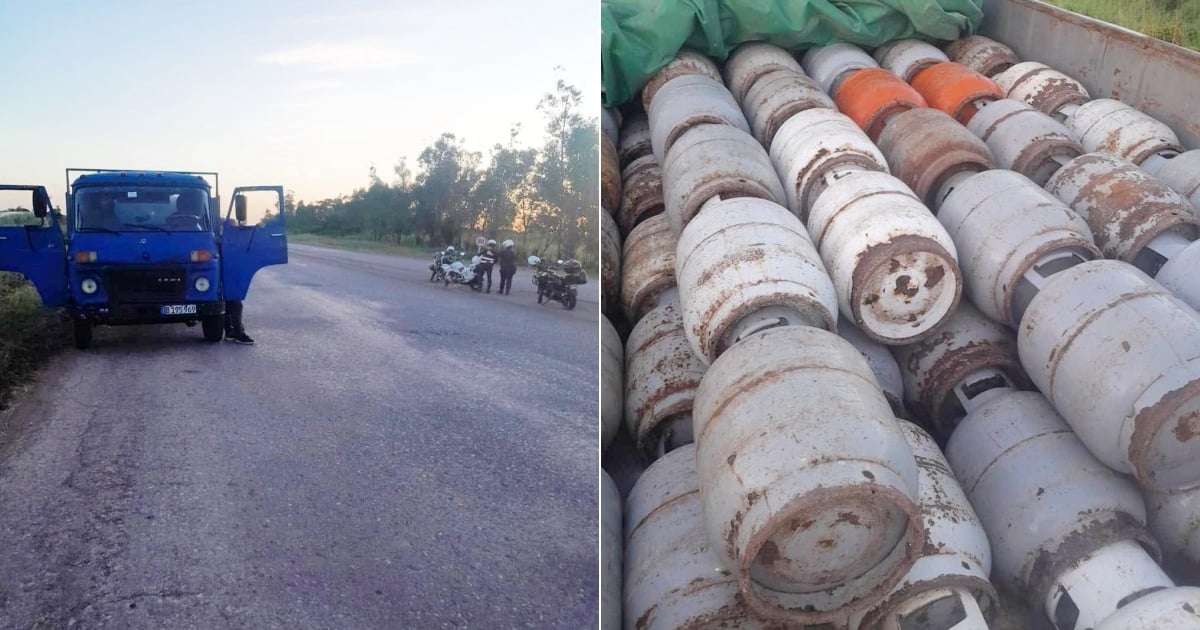
A truck belonging to Agri-Supplies in the municipality of Los Palacios, Pinar del Río, was intercepted by the police on the highway with "79 illegal liquefied gas cylinders."
The information – shared on Facebook by the official digital creator Alberto Roque Ramos – was reproduced by Cubadebate, which did not provide additional details about the circumstances of the incident or those involved.
"How much was this man earning at the expense of the people? With the current situation regarding liquefied gas. Now he must answer to the authorities," questioned Roque Ramos as he made the complaint.
As of the closure of this report, no further details are available regarding the incident, which occurs amid a severe shortage of the product that is essential for cooking food for many Cuban families, especially in light of the increasing power outages that restrict the use of electrical appliances.
At the end of October, it was reported in a Revolico group from Majagua, Ciego de Ávila, that a gas cylinder was being sold for 45,000 pesos, a price that rose to 60,000 CUP if the buyer was interested in obtaining the contract documents.
After a period of severe shortage, the distribution of Liquefied Petroleum Gas (LPG) resumed last Friday in Cuba following the arrival of a ship carrying 9,377 tons of the product to the "Hermanos Díaz" refinery in Santiago de Cuba. However, authorities acknowledged that the delivery will not meet the high accumulated demand in the country.
Irenaldo Pérez Cardoso, deputy director of the Cuba-Petroleum Union (CUPET), explained to Cubadebate that the current distribution aims to mitigate the "gap in fuel delivery" caused by delays in the arrival of LPG.
This shortage affected a significant proportion of the 1.7 million registered clients on the island. In Havana, Artemisa, and Mayabeque, 20% of consumers were unable to receive the service, while in the rest of the country, the figure rose to 63%, equivalent to over 735,000 clients.
The official attributed these difficulties to complications in international payments resulting from the economic sanctions imposed by the United States government. Pérez Cardoso explained that Cuba is now required to pay 100% upfront before unloading, which increases freight costs and causes additional delays due to issues with bank transfers.
To address the shortage, distribution will prioritize those consumers who were unable to access LPG in the previous cycle.
In provinces such as Havana, Mayabeque, and Artemisa, during the first four days of delivery, the product will be exclusively for these customers, based on lists published by commercial houses. In other provinces, this process will be extended over five days.
Despite these efforts, the estimated coverage of LPG with the current delivery is only 17 to 20 days. Authorities are also assessing the reorganization of delivery cycles to serve consumers more equitably, paying particular attention to vulnerable households.
Frequently Asked Questions about the Liquefied Gas Crisis in Cuba
What happened with the truck intercepted carrying liquefied gas in Cuba?
A state truck was intercepted with 79 illegal liquefied gas cylinders on the highway by the police. This incident reflects the corruption and black market that exacerbate the gas shortage crisis on the island.
Why is there a shortage of liquefied gas in Cuba?
The shortage of liquefied gas in Cuba is due to financial and logistical issues affecting imports, worsened by U.S. economic sanctions. This has resulted in limited distribution, which does not meet the high demand.
How is the government managing the distribution of liquefied gas?
The Cuban government prioritizes the distribution of liquefied gas to consumers who did not receive the product in the previous cycle. Lists are being implemented to organize the delivery in specific provinces during an initial distribution period.
What alternatives do Cubans have in the face of the shortage of liquefied gas?
Due to the shortage of liquefied gas, many Cubans are turning to wood or charcoal stoves for cooking. The sale of charcoal burners has seen a resurgence, although high prices reflect the seriousness of the energy crisis.
How long can the current supply of liquefied gas in Cuba last?
The estimated coverage of liquefied gas with the current supply is only 17 to 20 days, which represents a temporary and limited solution to the existing demand in the country.
Filed under: